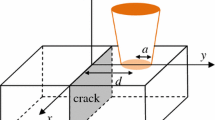Abstract
This paper discusses surface crack detection by photothermal radiometric imaging (PRI). In PRI, also called dynamic infrared scanning, a surface is scanned with a spot of heat. Imperfections are detected by radiometrically sensing changes in the surface temperature of a small area in the vicinity of this spot. In the work described, cracks narrower than 25 µm (0.001 in.) in a lightly rusted steel surface have been detected. Indiscrete scanning an amplitude modulated heating beam is moved in steps, remaining at each location long enough to measure amplitude and phase of the AC temperature. Incontinuous scanning a constant intensity heating beam is moved continuously while the temperature deviations are measured. This paper presents methods of calculating amplitude and phase of surface temperature for discrete scanning and instantaneous temperature for continuous scanning across a surface crack. For a steel surface scanned by a watt-level laser beam, predicted surface temperature deviations when crossing the crack are several degrees Celsius, with expected radiometrically detected power several orders of magnitude above the detector noise. In experiments performed, both techniques easily detected narrow cracks in a smooth, clean surface. Discolorations and pits, on the other hand, generate a disturbing type of “surface noise.” This noise was minimized by differential detection. Based on results obtained, continuously scanned PRI with a fan-type heating beam and array detection could become a viable way of map** surface cracks at practical scanning speeds.
Similar content being viewed by others
References
D. R. Green, Principles and applications of emittance-independent infrared nondestructive testing,Appl. Optics 7:1779–1789 (1968).
D. R. Maley and G. J. Posakony, A thermal scanning technique for nondestructive testing,Proc. Fourth Annual Symposium on Nondestructive Testing of Aircraft and Missile Components (Feb. 26–28, 1963, San Antonio, Texas, pp. 11–51.
E. J. Kubiak, Infrared detection of fatigue cracks and other near-surface defects,Appl. Optics 7:1743–1747 (1968).
Allen Rosencwaig,Photoacoustics and Photoacoustic Spectroscopy (John Wiley & Sons, New York, 1980).
P. E. Nordal and S. O. Kanstad, Photothermal radiometry,Physica Scripta (Sweden)20:659–662 (1979).
Allan Rosencwaig, Thermal wave microscopy with photoacoustics,J. Appl. Phys. 51:2210–2211 (1980).
M. Luukkala, Photoacoustic microscopy at low modulation frequencies, in E. A. Ash (ed.),Scanned Image Microscopy (Academic Press, New York, 1980).
R. L. Thomas, J. J. Pouch, Y. H. Wong, L. D. Favro, P. K. Kuo, and Allan Rosencwaig, Subsurface flaw detection in metals by photoacoustic microscopy,J. Appl. Phys. 51:1152–1156 (1980).
J. C. Murphy and L. C. Aamodt, Optically detected photothermal imaging,Appl. Phys. Lett. 38:196–198 (1981).
Gerd Busse, Optoacoustic and photothermal material inspection techniques,Applied Optics 21:107–110 (1982).
Allan Rosencwaig, Thermal wave imaging,Science 218:223–228 (1982).
S. M. De Almeida and B. K. Hinds, Finite difference solution to the problem of temperature distribution under a moving heat source, using the concept of a quasi-stationary state.Numerical Heat Transfer 6:17–27 (1983).
M. Lax, Temperature rise induced by a laser beam,J. Appl. Phys. 48:3919–3924 (1977).
D. Rosenthal, The theory of moving sources of heat and its application to metal treatments,Transactions of the A.S.M.E. 68:849–866 (1946).
H. S. Carslaw and J. C. Jaeger,Conduction of Heat in Solids, Second Edition (Clarendon Press, Oxford, 1959), pp. 266–270.
Boris Podolsky, A problem in heat conduction,J. Appl. Phys. 22:581–585 (1951).
R. H. Ritchie, The temperature function in a moving medium,J. Appl. Phys. 22:1389 (1951).
J. E. Moody and R. H. Hendel, Temperature profiles induced by a scanning cw laser beam,J. Appl. Phys. 53:4364–4371 (1982).
P. K. Khandelwal, P. W. Heitman, A. J. Silversmith, and T. D. Wakefield, Surface flaw detection in structural ceramics by scanning photoacoustic spectroscopy,Appl. Phys. Lett. 39:779–781 (1980).
K. R. Grice, L. J. Inglehart, L. D. Favro, P. K. Kuo, and R. L. Thomas, Thermal wave imaging of cracks in metals,J. Physique 44:C6-519–C6-524 (1983).
R. L. Thomas, L. D. Favro, K. R. Grice, L. J. Inglehart, P. K. Kuo, J. Lhota, and Gerd Busse, Thermal wave imaging for nondestructive evaluation,Proceedings of 1982 IEEE Ultrasonics Symposium, pp. 586–590.
J. D. Birkeland,A Photothermal Radiometer for Concentration Solar Cell Measurement (M. S. Thesis, Arizona State Univ., Dec. 1985).
W. N. Reynolds, Thermographic methods applied to industrial materials,Can. J. Phys. 64:1150–1154 (1986).
D. M. Heath, C. S. Welch, W. P. Winfree, J. S. Heyman, and W. E. Miller, Quantitative thermal diffusivity measurements of composites, in D. O. Thompson and D. E. Chimenti (eds.)Review of Progress in Quantitative Nondestructive Evaluation, (Plenum Publishing Corp., New York, 1986), Vol. 5B, pp. 1125–1132.
C. S. Welch, D. M. Heath, and W. P. Winfree, Quantitative thermal characterization of thin plates, in D. O. Thompson and D. E. Chimenti (eds.)Review of Progress in Quantitative Nondestructive Evaluation, (Plenum Publishing Corp., New York, 1986), Vol. 5B, pp. 1133–1139.
K. R. Grice, L. J. Inglehart, L. D. Favro, P. K. Kuo, and R. L. Thomas, Thermal wave imaging of closed cracks in opaque solids,J. Appl. Phys. 54:6245–6255 (1983).
Author information
Authors and Affiliations
Rights and permissions
About this article
Cite this article
Kaufman, I., Chang, PT., Hsu, HS. et al. Photothermal radiometric detection and imaging of surface cracks. J Nondestruct Eval 6, 87–100 (1987). https://doi.org/10.1007/BF00568887
Received:
Revised:
Issue Date:
DOI: https://doi.org/10.1007/BF00568887




